Project Management Critical Success Factors: Research Report Analysis
VerifiedAdded on 2022/08/28
|16
|4161
|16
Report
AI Summary
This report delves into the critical success factors in project management, examining elements that contribute to project success or failure. It highlights the significance of leadership vision, strategic planning, effective communication, risk management, resource and time management, and market orientation. The research emphasizes how a clear leadership vision, coupled with effective communication strategies, is essential for project success. The report also explores the importance of strategic planning, risk assessment, and efficient resource and time management. The project management framework and methodology are also discussed, with a focus on how these elements need to be tailored to specific project needs. The report concludes by emphasizing the role of documentation and communication, and the importance of aligning projects with market demands. The report is based on the provided assignment brief and includes an abstract, introduction, and conclusion. The report adheres to APA format with a minimum of six sources, at least four from peer-reviewed journals.

Project Management Critical Success Factors
Name of student:
Institutional Affiliations:
Name of student:
Institutional Affiliations:
Paraphrase This Document
Need a fresh take? Get an instant paraphrase of this document with our AI Paraphraser
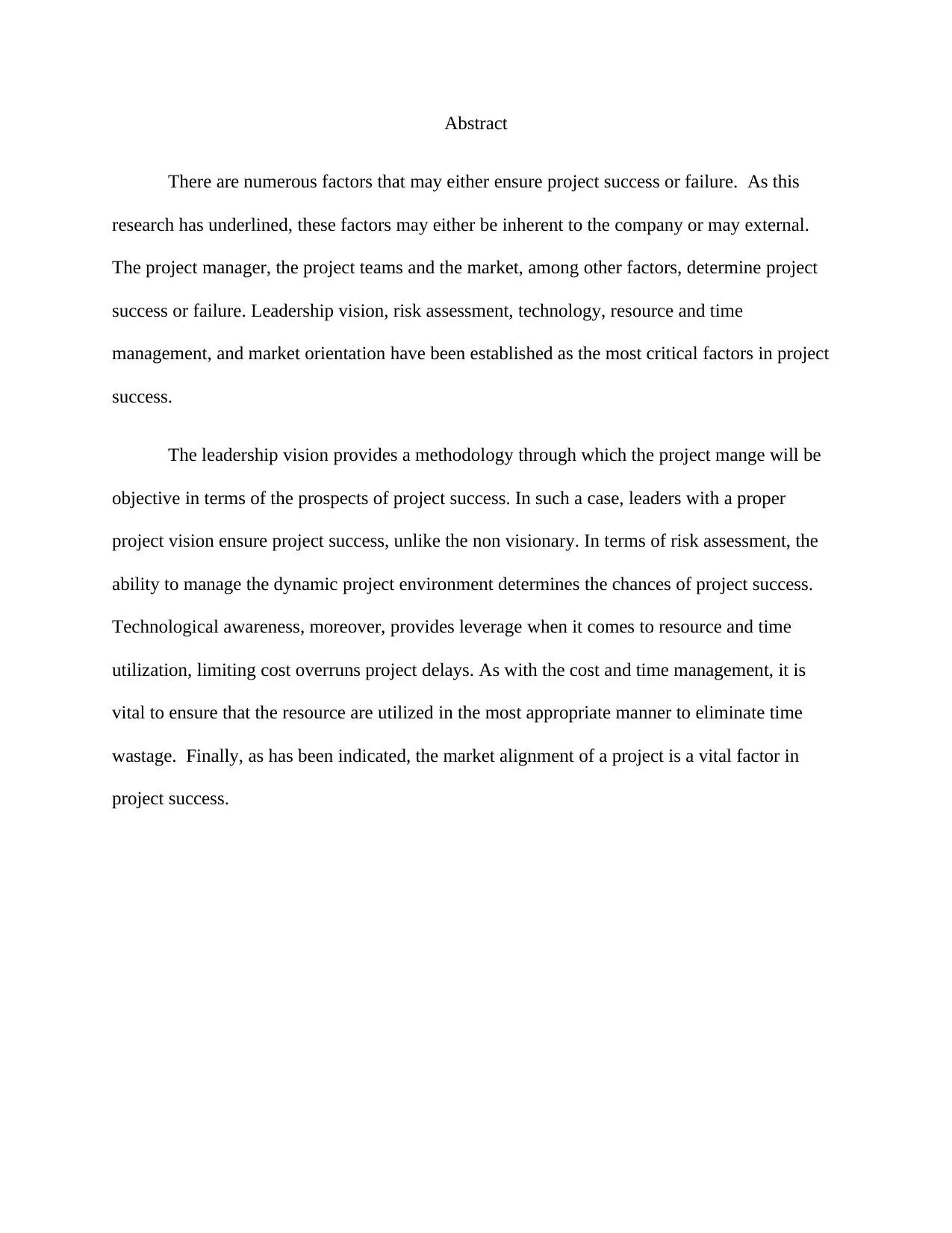
Abstract
There are numerous factors that may either ensure project success or failure. As this
research has underlined, these factors may either be inherent to the company or may external.
The project manager, the project teams and the market, among other factors, determine project
success or failure. Leadership vision, risk assessment, technology, resource and time
management, and market orientation have been established as the most critical factors in project
success.
The leadership vision provides a methodology through which the project mange will be
objective in terms of the prospects of project success. In such a case, leaders with a proper
project vision ensure project success, unlike the non visionary. In terms of risk assessment, the
ability to manage the dynamic project environment determines the chances of project success.
Technological awareness, moreover, provides leverage when it comes to resource and time
utilization, limiting cost overruns project delays. As with the cost and time management, it is
vital to ensure that the resource are utilized in the most appropriate manner to eliminate time
wastage. Finally, as has been indicated, the market alignment of a project is a vital factor in
project success.
There are numerous factors that may either ensure project success or failure. As this
research has underlined, these factors may either be inherent to the company or may external.
The project manager, the project teams and the market, among other factors, determine project
success or failure. Leadership vision, risk assessment, technology, resource and time
management, and market orientation have been established as the most critical factors in project
success.
The leadership vision provides a methodology through which the project mange will be
objective in terms of the prospects of project success. In such a case, leaders with a proper
project vision ensure project success, unlike the non visionary. In terms of risk assessment, the
ability to manage the dynamic project environment determines the chances of project success.
Technological awareness, moreover, provides leverage when it comes to resource and time
utilization, limiting cost overruns project delays. As with the cost and time management, it is
vital to ensure that the resource are utilized in the most appropriate manner to eliminate time
wastage. Finally, as has been indicated, the market alignment of a project is a vital factor in
project success.
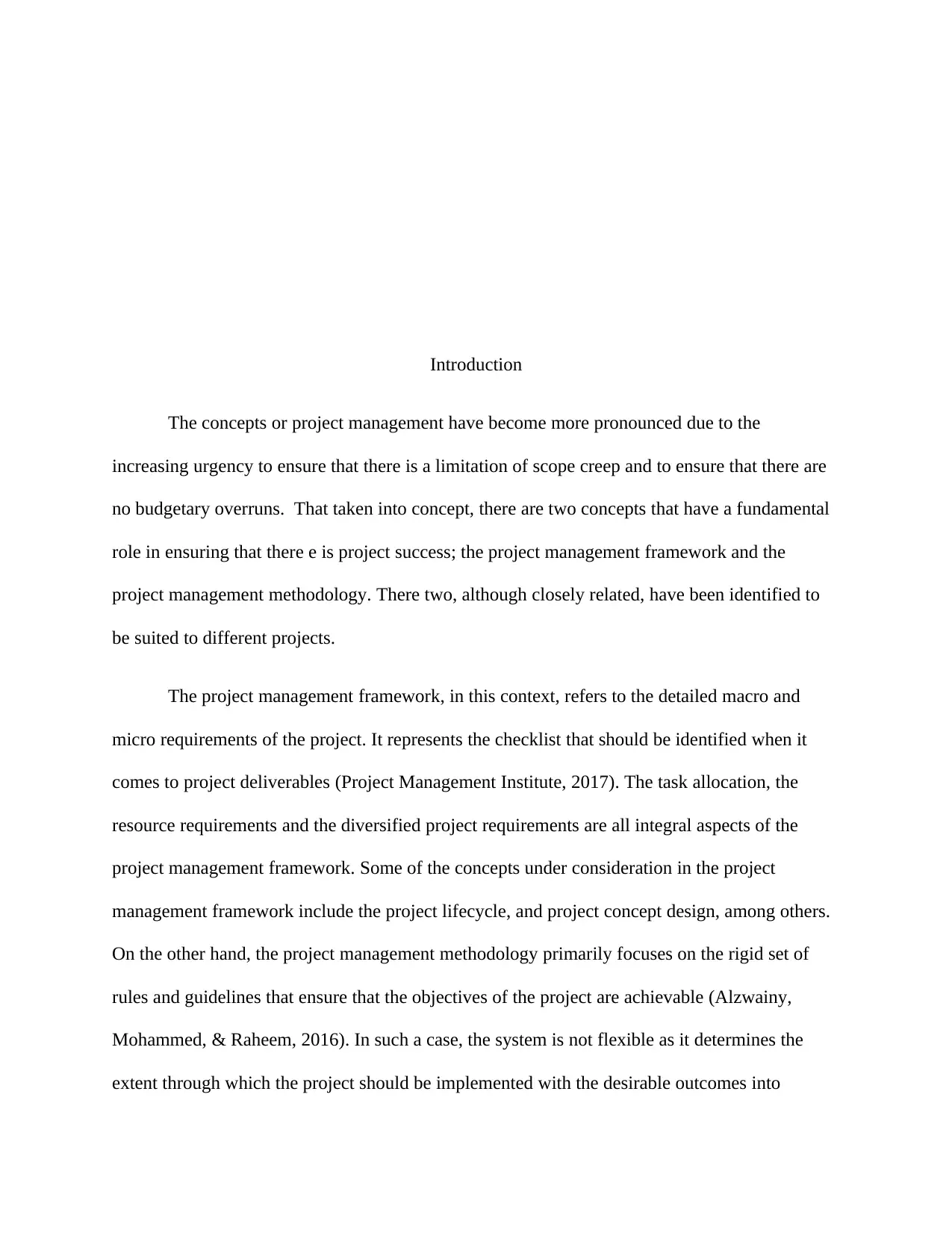
Introduction
The concepts or project management have become more pronounced due to the
increasing urgency to ensure that there is a limitation of scope creep and to ensure that there are
no budgetary overruns. That taken into concept, there are two concepts that have a fundamental
role in ensuring that there e is project success; the project management framework and the
project management methodology. There two, although closely related, have been identified to
be suited to different projects.
The project management framework, in this context, refers to the detailed macro and
micro requirements of the project. It represents the checklist that should be identified when it
comes to project deliverables (Project Management Institute, 2017). The task allocation, the
resource requirements and the diversified project requirements are all integral aspects of the
project management framework. Some of the concepts under consideration in the project
management framework include the project lifecycle, and project concept design, among others.
On the other hand, the project management methodology primarily focuses on the rigid set of
rules and guidelines that ensure that the objectives of the project are achievable (Alzwainy,
Mohammed, & Raheem, 2016). In such a case, the system is not flexible as it determines the
extent through which the project should be implemented with the desirable outcomes into
The concepts or project management have become more pronounced due to the
increasing urgency to ensure that there is a limitation of scope creep and to ensure that there are
no budgetary overruns. That taken into concept, there are two concepts that have a fundamental
role in ensuring that there e is project success; the project management framework and the
project management methodology. There two, although closely related, have been identified to
be suited to different projects.
The project management framework, in this context, refers to the detailed macro and
micro requirements of the project. It represents the checklist that should be identified when it
comes to project deliverables (Project Management Institute, 2017). The task allocation, the
resource requirements and the diversified project requirements are all integral aspects of the
project management framework. Some of the concepts under consideration in the project
management framework include the project lifecycle, and project concept design, among others.
On the other hand, the project management methodology primarily focuses on the rigid set of
rules and guidelines that ensure that the objectives of the project are achievable (Alzwainy,
Mohammed, & Raheem, 2016). In such a case, the system is not flexible as it determines the
extent through which the project should be implemented with the desirable outcomes into
⊘ This is a preview!⊘
Do you want full access?
Subscribe today to unlock all pages.

Trusted by 1+ million students worldwide
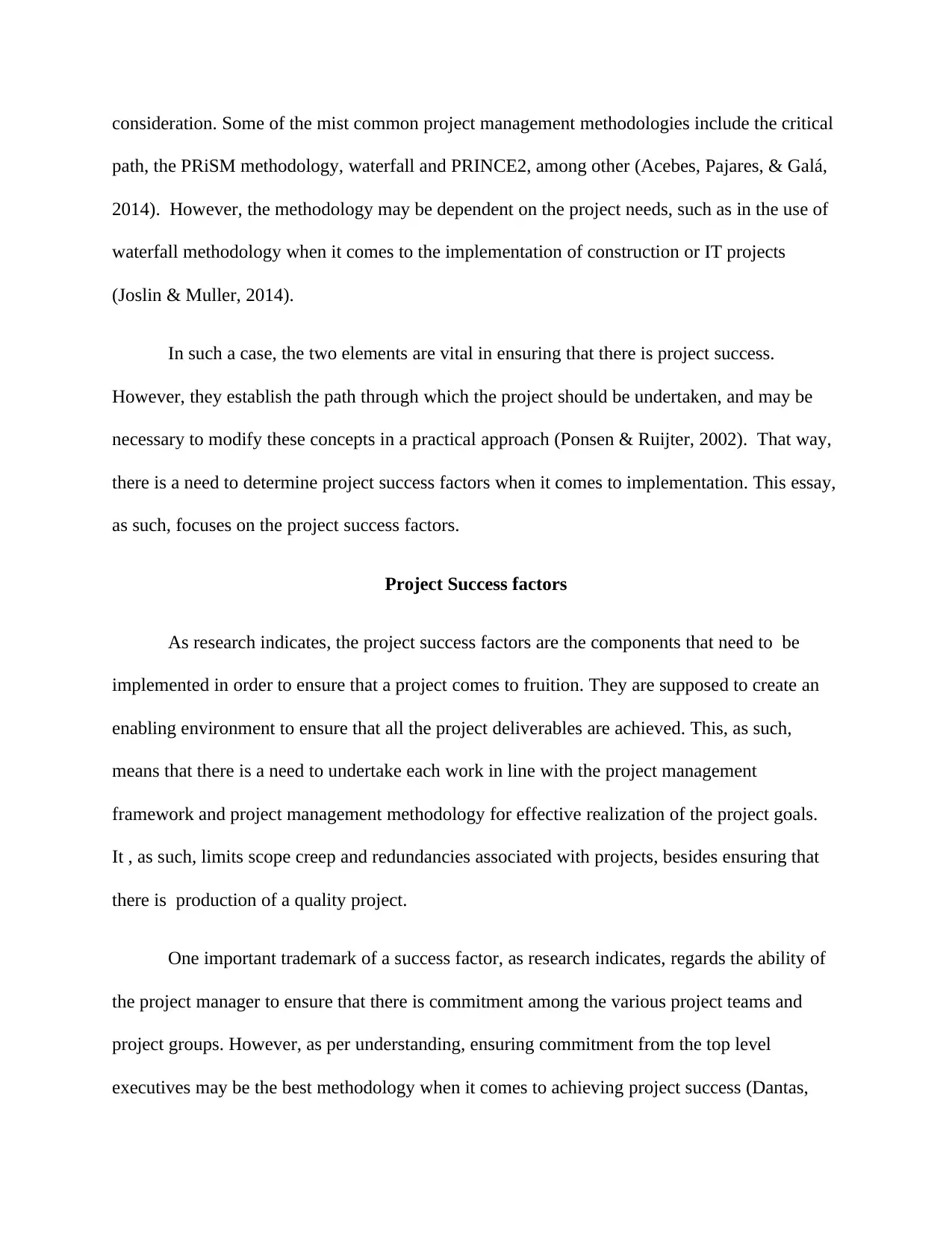
consideration. Some of the mist common project management methodologies include the critical
path, the PRiSM methodology, waterfall and PRINCE2, among other (Acebes, Pajares, & Galá,
2014). However, the methodology may be dependent on the project needs, such as in the use of
waterfall methodology when it comes to the implementation of construction or IT projects
(Joslin & Muller, 2014).
In such a case, the two elements are vital in ensuring that there is project success.
However, they establish the path through which the project should be undertaken, and may be
necessary to modify these concepts in a practical approach (Ponsen & Ruijter, 2002). That way,
there is a need to determine project success factors when it comes to implementation. This essay,
as such, focuses on the project success factors.
Project Success factors
As research indicates, the project success factors are the components that need to be
implemented in order to ensure that a project comes to fruition. They are supposed to create an
enabling environment to ensure that all the project deliverables are achieved. This, as such,
means that there is a need to undertake each work in line with the project management
framework and project management methodology for effective realization of the project goals.
It , as such, limits scope creep and redundancies associated with projects, besides ensuring that
there is production of a quality project.
One important trademark of a success factor, as research indicates, regards the ability of
the project manager to ensure that there is commitment among the various project teams and
project groups. However, as per understanding, ensuring commitment from the top level
executives may be the best methodology when it comes to achieving project success (Dantas,
path, the PRiSM methodology, waterfall and PRINCE2, among other (Acebes, Pajares, & Galá,
2014). However, the methodology may be dependent on the project needs, such as in the use of
waterfall methodology when it comes to the implementation of construction or IT projects
(Joslin & Muller, 2014).
In such a case, the two elements are vital in ensuring that there is project success.
However, they establish the path through which the project should be undertaken, and may be
necessary to modify these concepts in a practical approach (Ponsen & Ruijter, 2002). That way,
there is a need to determine project success factors when it comes to implementation. This essay,
as such, focuses on the project success factors.
Project Success factors
As research indicates, the project success factors are the components that need to be
implemented in order to ensure that a project comes to fruition. They are supposed to create an
enabling environment to ensure that all the project deliverables are achieved. This, as such,
means that there is a need to undertake each work in line with the project management
framework and project management methodology for effective realization of the project goals.
It , as such, limits scope creep and redundancies associated with projects, besides ensuring that
there is production of a quality project.
One important trademark of a success factor, as research indicates, regards the ability of
the project manager to ensure that there is commitment among the various project teams and
project groups. However, as per understanding, ensuring commitment from the top level
executives may be the best methodology when it comes to achieving project success (Dantas,
Paraphrase This Document
Need a fresh take? Get an instant paraphrase of this document with our AI Paraphraser
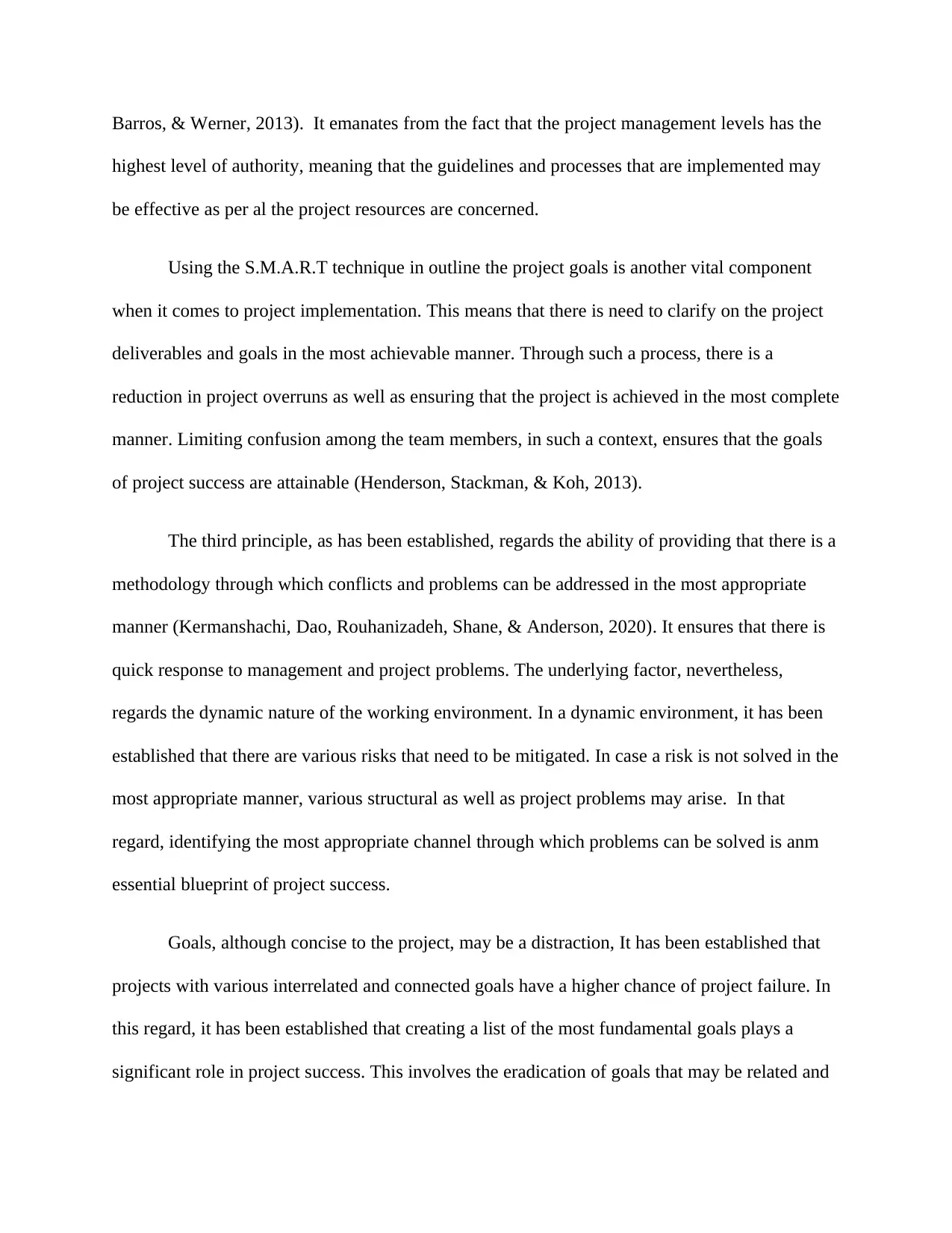
Barros, & Werner, 2013). It emanates from the fact that the project management levels has the
highest level of authority, meaning that the guidelines and processes that are implemented may
be effective as per al the project resources are concerned.
Using the S.M.A.R.T technique in outline the project goals is another vital component
when it comes to project implementation. This means that there is need to clarify on the project
deliverables and goals in the most achievable manner. Through such a process, there is a
reduction in project overruns as well as ensuring that the project is achieved in the most complete
manner. Limiting confusion among the team members, in such a context, ensures that the goals
of project success are attainable (Henderson, Stackman, & Koh, 2013).
The third principle, as has been established, regards the ability of providing that there is a
methodology through which conflicts and problems can be addressed in the most appropriate
manner (Kermanshachi, Dao, Rouhanizadeh, Shane, & Anderson, 2020). It ensures that there is
quick response to management and project problems. The underlying factor, nevertheless,
regards the dynamic nature of the working environment. In a dynamic environment, it has been
established that there are various risks that need to be mitigated. In case a risk is not solved in the
most appropriate manner, various structural as well as project problems may arise. In that
regard, identifying the most appropriate channel through which problems can be solved is anm
essential blueprint of project success.
Goals, although concise to the project, may be a distraction, It has been established that
projects with various interrelated and connected goals have a higher chance of project failure. In
this regard, it has been established that creating a list of the most fundamental goals plays a
significant role in project success. This involves the eradication of goals that may be related and
highest level of authority, meaning that the guidelines and processes that are implemented may
be effective as per al the project resources are concerned.
Using the S.M.A.R.T technique in outline the project goals is another vital component
when it comes to project implementation. This means that there is need to clarify on the project
deliverables and goals in the most achievable manner. Through such a process, there is a
reduction in project overruns as well as ensuring that the project is achieved in the most complete
manner. Limiting confusion among the team members, in such a context, ensures that the goals
of project success are attainable (Henderson, Stackman, & Koh, 2013).
The third principle, as has been established, regards the ability of providing that there is a
methodology through which conflicts and problems can be addressed in the most appropriate
manner (Kermanshachi, Dao, Rouhanizadeh, Shane, & Anderson, 2020). It ensures that there is
quick response to management and project problems. The underlying factor, nevertheless,
regards the dynamic nature of the working environment. In a dynamic environment, it has been
established that there are various risks that need to be mitigated. In case a risk is not solved in the
most appropriate manner, various structural as well as project problems may arise. In that
regard, identifying the most appropriate channel through which problems can be solved is anm
essential blueprint of project success.
Goals, although concise to the project, may be a distraction, It has been established that
projects with various interrelated and connected goals have a higher chance of project failure. In
this regard, it has been established that creating a list of the most fundamental goals plays a
significant role in project success. This involves the eradication of goals that may be related and
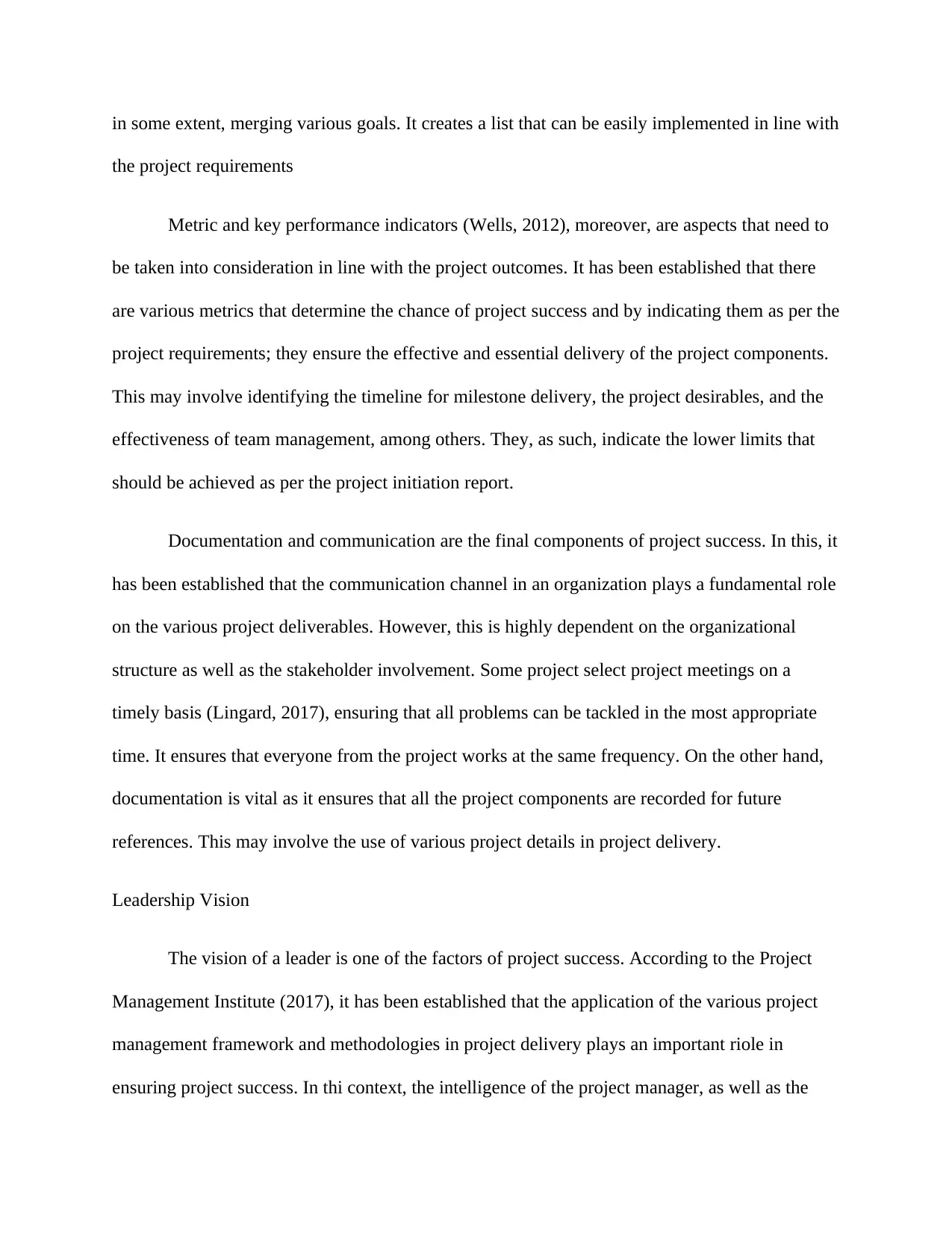
in some extent, merging various goals. It creates a list that can be easily implemented in line with
the project requirements
Metric and key performance indicators (Wells, 2012), moreover, are aspects that need to
be taken into consideration in line with the project outcomes. It has been established that there
are various metrics that determine the chance of project success and by indicating them as per the
project requirements; they ensure the effective and essential delivery of the project components.
This may involve identifying the timeline for milestone delivery, the project desirables, and the
effectiveness of team management, among others. They, as such, indicate the lower limits that
should be achieved as per the project initiation report.
Documentation and communication are the final components of project success. In this, it
has been established that the communication channel in an organization plays a fundamental role
on the various project deliverables. However, this is highly dependent on the organizational
structure as well as the stakeholder involvement. Some project select project meetings on a
timely basis (Lingard, 2017), ensuring that all problems can be tackled in the most appropriate
time. It ensures that everyone from the project works at the same frequency. On the other hand,
documentation is vital as it ensures that all the project components are recorded for future
references. This may involve the use of various project details in project delivery.
Leadership Vision
The vision of a leader is one of the factors of project success. According to the Project
Management Institute (2017), it has been established that the application of the various project
management framework and methodologies in project delivery plays an important riole in
ensuring project success. In thi context, the intelligence of the project manager, as well as the
the project requirements
Metric and key performance indicators (Wells, 2012), moreover, are aspects that need to
be taken into consideration in line with the project outcomes. It has been established that there
are various metrics that determine the chance of project success and by indicating them as per the
project requirements; they ensure the effective and essential delivery of the project components.
This may involve identifying the timeline for milestone delivery, the project desirables, and the
effectiveness of team management, among others. They, as such, indicate the lower limits that
should be achieved as per the project initiation report.
Documentation and communication are the final components of project success. In this, it
has been established that the communication channel in an organization plays a fundamental role
on the various project deliverables. However, this is highly dependent on the organizational
structure as well as the stakeholder involvement. Some project select project meetings on a
timely basis (Lingard, 2017), ensuring that all problems can be tackled in the most appropriate
time. It ensures that everyone from the project works at the same frequency. On the other hand,
documentation is vital as it ensures that all the project components are recorded for future
references. This may involve the use of various project details in project delivery.
Leadership Vision
The vision of a leader is one of the factors of project success. According to the Project
Management Institute (2017), it has been established that the application of the various project
management framework and methodologies in project delivery plays an important riole in
ensuring project success. In thi context, the intelligence of the project manager, as well as the
⊘ This is a preview!⊘
Do you want full access?
Subscribe today to unlock all pages.

Trusted by 1+ million students worldwide
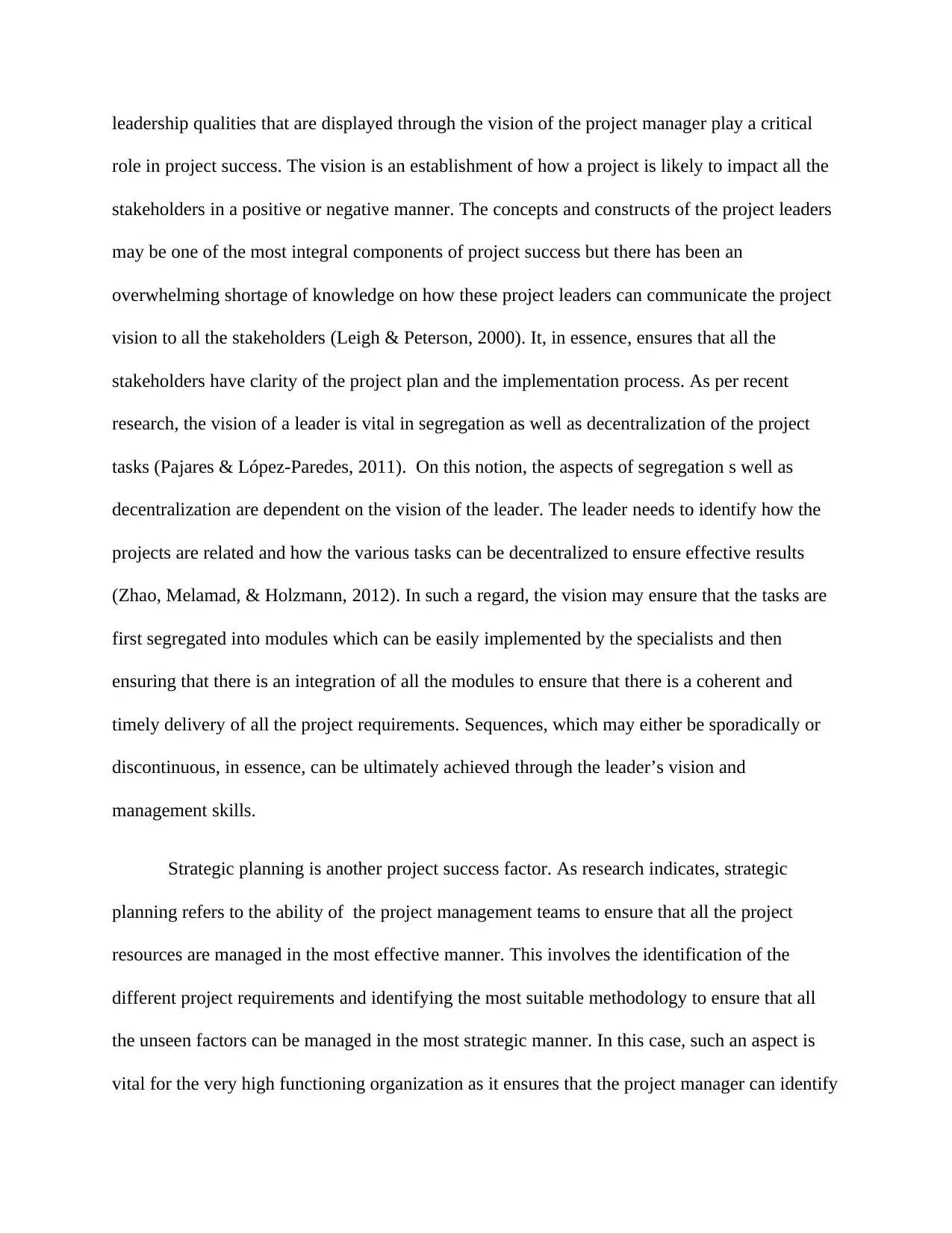
leadership qualities that are displayed through the vision of the project manager play a critical
role in project success. The vision is an establishment of how a project is likely to impact all the
stakeholders in a positive or negative manner. The concepts and constructs of the project leaders
may be one of the most integral components of project success but there has been an
overwhelming shortage of knowledge on how these project leaders can communicate the project
vision to all the stakeholders (Leigh & Peterson, 2000). It, in essence, ensures that all the
stakeholders have clarity of the project plan and the implementation process. As per recent
research, the vision of a leader is vital in segregation as well as decentralization of the project
tasks (Pajares & López-Paredes, 2011). On this notion, the aspects of segregation s well as
decentralization are dependent on the vision of the leader. The leader needs to identify how the
projects are related and how the various tasks can be decentralized to ensure effective results
(Zhao, Melamad, & Holzmann, 2012). In such a regard, the vision may ensure that the tasks are
first segregated into modules which can be easily implemented by the specialists and then
ensuring that there is an integration of all the modules to ensure that there is a coherent and
timely delivery of all the project requirements. Sequences, which may either be sporadically or
discontinuous, in essence, can be ultimately achieved through the leader’s vision and
management skills.
Strategic planning is another project success factor. As research indicates, strategic
planning refers to the ability of the project management teams to ensure that all the project
resources are managed in the most effective manner. This involves the identification of the
different project requirements and identifying the most suitable methodology to ensure that all
the unseen factors can be managed in the most strategic manner. In this case, such an aspect is
vital for the very high functioning organization as it ensures that the project manager can identify
role in project success. The vision is an establishment of how a project is likely to impact all the
stakeholders in a positive or negative manner. The concepts and constructs of the project leaders
may be one of the most integral components of project success but there has been an
overwhelming shortage of knowledge on how these project leaders can communicate the project
vision to all the stakeholders (Leigh & Peterson, 2000). It, in essence, ensures that all the
stakeholders have clarity of the project plan and the implementation process. As per recent
research, the vision of a leader is vital in segregation as well as decentralization of the project
tasks (Pajares & López-Paredes, 2011). On this notion, the aspects of segregation s well as
decentralization are dependent on the vision of the leader. The leader needs to identify how the
projects are related and how the various tasks can be decentralized to ensure effective results
(Zhao, Melamad, & Holzmann, 2012). In such a regard, the vision may ensure that the tasks are
first segregated into modules which can be easily implemented by the specialists and then
ensuring that there is an integration of all the modules to ensure that there is a coherent and
timely delivery of all the project requirements. Sequences, which may either be sporadically or
discontinuous, in essence, can be ultimately achieved through the leader’s vision and
management skills.
Strategic planning is another project success factor. As research indicates, strategic
planning refers to the ability of the project management teams to ensure that all the project
resources are managed in the most effective manner. This involves the identification of the
different project requirements and identifying the most suitable methodology to ensure that all
the unseen factors can be managed in the most strategic manner. In this case, such an aspect is
vital for the very high functioning organization as it ensures that the project manager can identify
Paraphrase This Document
Need a fresh take? Get an instant paraphrase of this document with our AI Paraphraser
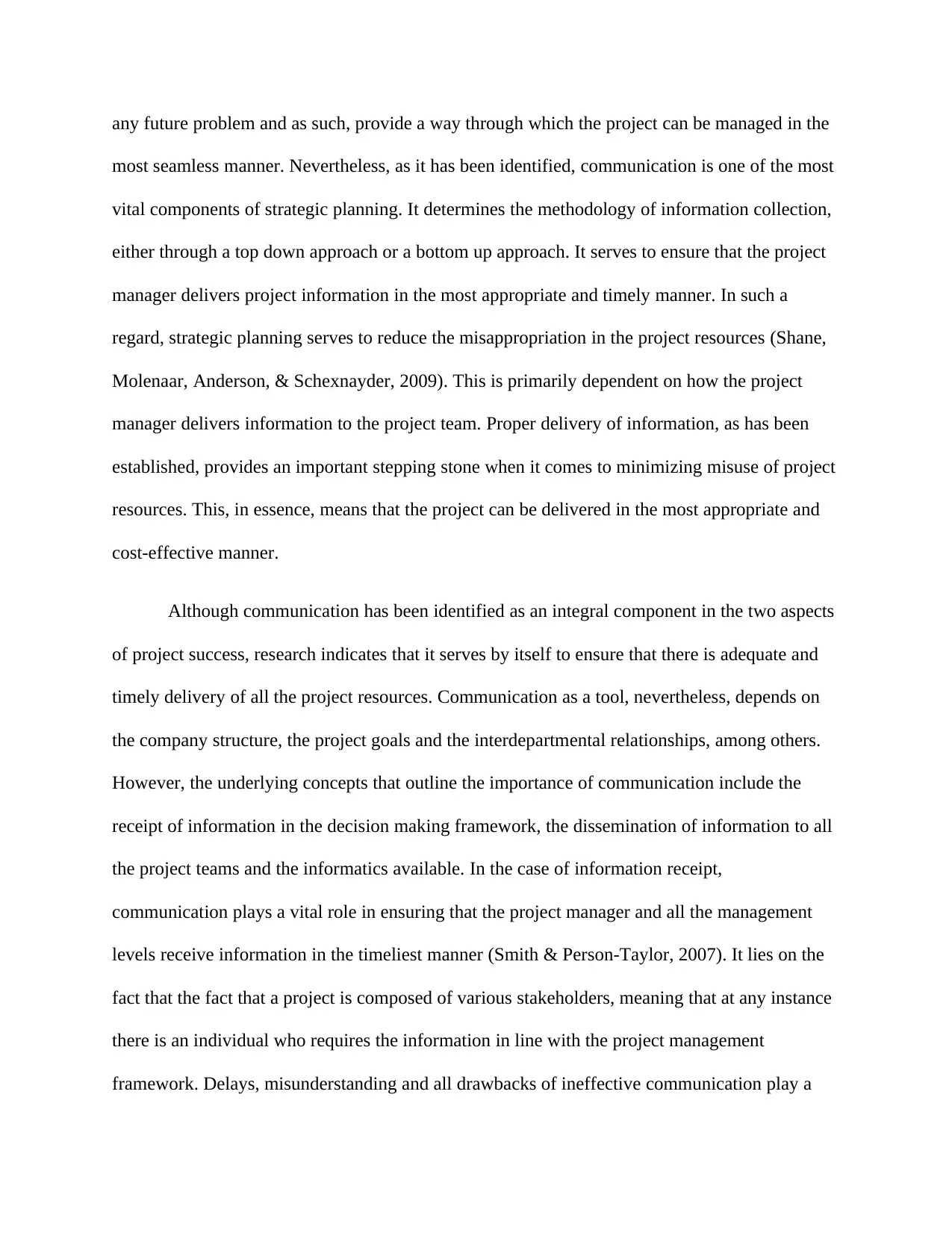
any future problem and as such, provide a way through which the project can be managed in the
most seamless manner. Nevertheless, as it has been identified, communication is one of the most
vital components of strategic planning. It determines the methodology of information collection,
either through a top down approach or a bottom up approach. It serves to ensure that the project
manager delivers project information in the most appropriate and timely manner. In such a
regard, strategic planning serves to reduce the misappropriation in the project resources (Shane,
Molenaar, Anderson, & Schexnayder, 2009). This is primarily dependent on how the project
manager delivers information to the project team. Proper delivery of information, as has been
established, provides an important stepping stone when it comes to minimizing misuse of project
resources. This, in essence, means that the project can be delivered in the most appropriate and
cost-effective manner.
Although communication has been identified as an integral component in the two aspects
of project success, research indicates that it serves by itself to ensure that there is adequate and
timely delivery of all the project resources. Communication as a tool, nevertheless, depends on
the company structure, the project goals and the interdepartmental relationships, among others.
However, the underlying concepts that outline the importance of communication include the
receipt of information in the decision making framework, the dissemination of information to all
the project teams and the informatics available. In the case of information receipt,
communication plays a vital role in ensuring that the project manager and all the management
levels receive information in the timeliest manner (Smith & Person-Taylor, 2007). It lies on the
fact that the fact that a project is composed of various stakeholders, meaning that at any instance
there is an individual who requires the information in line with the project management
framework. Delays, misunderstanding and all drawbacks of ineffective communication play a
most seamless manner. Nevertheless, as it has been identified, communication is one of the most
vital components of strategic planning. It determines the methodology of information collection,
either through a top down approach or a bottom up approach. It serves to ensure that the project
manager delivers project information in the most appropriate and timely manner. In such a
regard, strategic planning serves to reduce the misappropriation in the project resources (Shane,
Molenaar, Anderson, & Schexnayder, 2009). This is primarily dependent on how the project
manager delivers information to the project team. Proper delivery of information, as has been
established, provides an important stepping stone when it comes to minimizing misuse of project
resources. This, in essence, means that the project can be delivered in the most appropriate and
cost-effective manner.
Although communication has been identified as an integral component in the two aspects
of project success, research indicates that it serves by itself to ensure that there is adequate and
timely delivery of all the project resources. Communication as a tool, nevertheless, depends on
the company structure, the project goals and the interdepartmental relationships, among others.
However, the underlying concepts that outline the importance of communication include the
receipt of information in the decision making framework, the dissemination of information to all
the project teams and the informatics available. In the case of information receipt,
communication plays a vital role in ensuring that the project manager and all the management
levels receive information in the timeliest manner (Smith & Person-Taylor, 2007). It lies on the
fact that the fact that a project is composed of various stakeholders, meaning that at any instance
there is an individual who requires the information in line with the project management
framework. Delays, misunderstanding and all drawbacks of ineffective communication play a
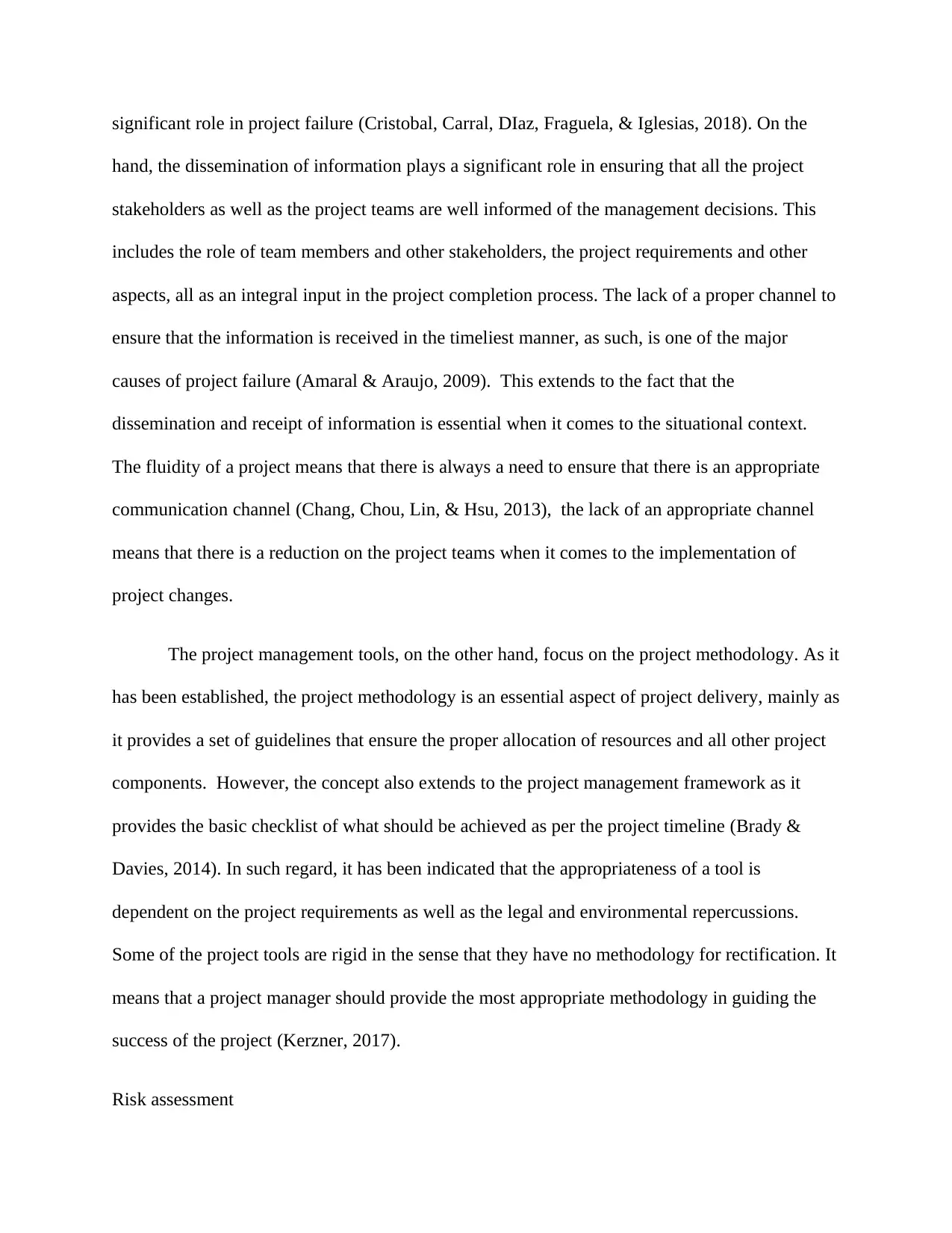
significant role in project failure (Cristobal, Carral, DIaz, Fraguela, & Iglesias, 2018). On the
hand, the dissemination of information plays a significant role in ensuring that all the project
stakeholders as well as the project teams are well informed of the management decisions. This
includes the role of team members and other stakeholders, the project requirements and other
aspects, all as an integral input in the project completion process. The lack of a proper channel to
ensure that the information is received in the timeliest manner, as such, is one of the major
causes of project failure (Amaral & Araujo, 2009). This extends to the fact that the
dissemination and receipt of information is essential when it comes to the situational context.
The fluidity of a project means that there is always a need to ensure that there is an appropriate
communication channel (Chang, Chou, Lin, & Hsu, 2013), the lack of an appropriate channel
means that there is a reduction on the project teams when it comes to the implementation of
project changes.
The project management tools, on the other hand, focus on the project methodology. As it
has been established, the project methodology is an essential aspect of project delivery, mainly as
it provides a set of guidelines that ensure the proper allocation of resources and all other project
components. However, the concept also extends to the project management framework as it
provides the basic checklist of what should be achieved as per the project timeline (Brady &
Davies, 2014). In such regard, it has been indicated that the appropriateness of a tool is
dependent on the project requirements as well as the legal and environmental repercussions.
Some of the project tools are rigid in the sense that they have no methodology for rectification. It
means that a project manager should provide the most appropriate methodology in guiding the
success of the project (Kerzner, 2017).
Risk assessment
hand, the dissemination of information plays a significant role in ensuring that all the project
stakeholders as well as the project teams are well informed of the management decisions. This
includes the role of team members and other stakeholders, the project requirements and other
aspects, all as an integral input in the project completion process. The lack of a proper channel to
ensure that the information is received in the timeliest manner, as such, is one of the major
causes of project failure (Amaral & Araujo, 2009). This extends to the fact that the
dissemination and receipt of information is essential when it comes to the situational context.
The fluidity of a project means that there is always a need to ensure that there is an appropriate
communication channel (Chang, Chou, Lin, & Hsu, 2013), the lack of an appropriate channel
means that there is a reduction on the project teams when it comes to the implementation of
project changes.
The project management tools, on the other hand, focus on the project methodology. As it
has been established, the project methodology is an essential aspect of project delivery, mainly as
it provides a set of guidelines that ensure the proper allocation of resources and all other project
components. However, the concept also extends to the project management framework as it
provides the basic checklist of what should be achieved as per the project timeline (Brady &
Davies, 2014). In such regard, it has been indicated that the appropriateness of a tool is
dependent on the project requirements as well as the legal and environmental repercussions.
Some of the project tools are rigid in the sense that they have no methodology for rectification. It
means that a project manager should provide the most appropriate methodology in guiding the
success of the project (Kerzner, 2017).
Risk assessment
⊘ This is a preview!⊘
Do you want full access?
Subscribe today to unlock all pages.

Trusted by 1+ million students worldwide
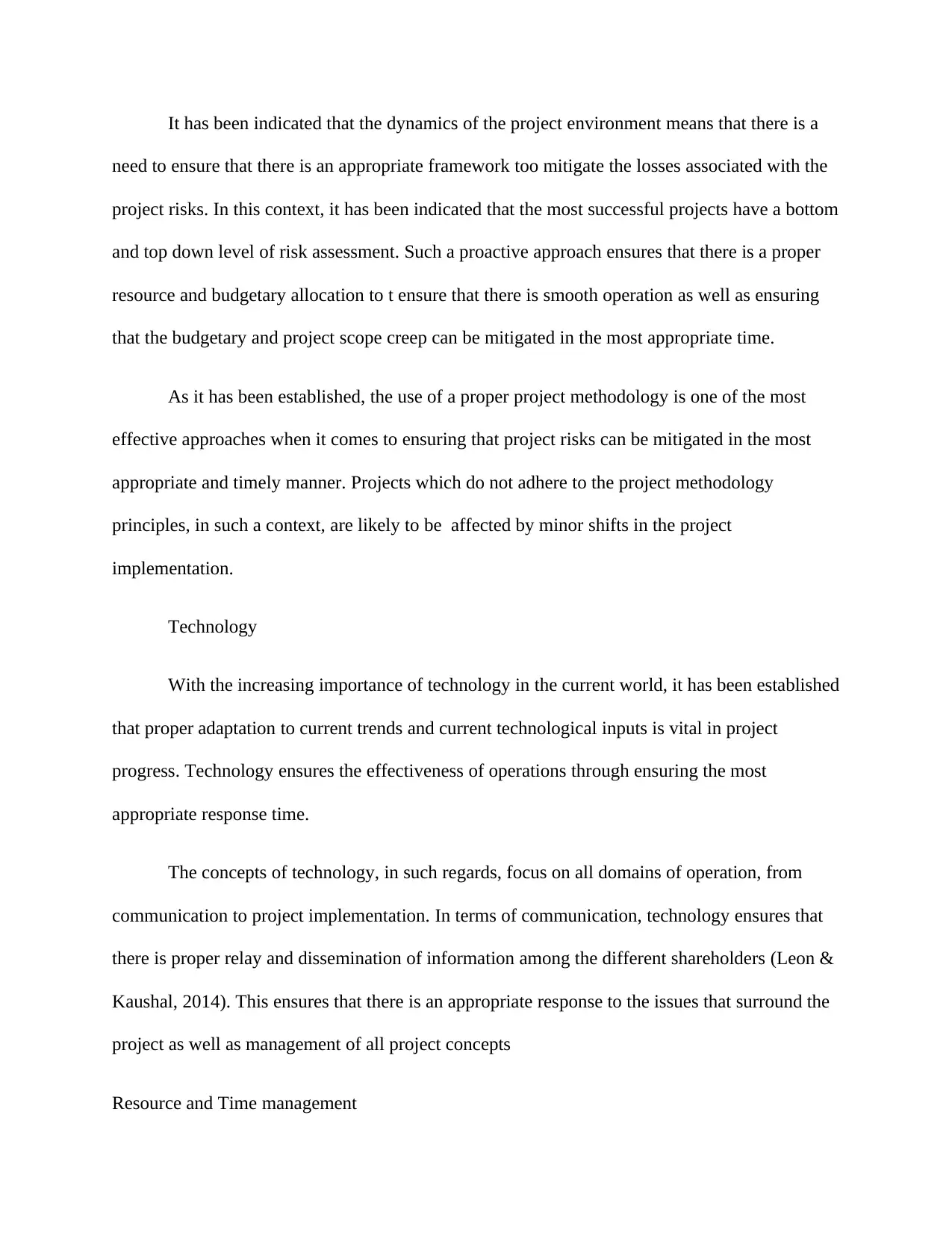
It has been indicated that the dynamics of the project environment means that there is a
need to ensure that there is an appropriate framework too mitigate the losses associated with the
project risks. In this context, it has been indicated that the most successful projects have a bottom
and top down level of risk assessment. Such a proactive approach ensures that there is a proper
resource and budgetary allocation to t ensure that there is smooth operation as well as ensuring
that the budgetary and project scope creep can be mitigated in the most appropriate time.
As it has been established, the use of a proper project methodology is one of the most
effective approaches when it comes to ensuring that project risks can be mitigated in the most
appropriate and timely manner. Projects which do not adhere to the project methodology
principles, in such a context, are likely to be affected by minor shifts in the project
implementation.
Technology
With the increasing importance of technology in the current world, it has been established
that proper adaptation to current trends and current technological inputs is vital in project
progress. Technology ensures the effectiveness of operations through ensuring the most
appropriate response time.
The concepts of technology, in such regards, focus on all domains of operation, from
communication to project implementation. In terms of communication, technology ensures that
there is proper relay and dissemination of information among the different shareholders (Leon &
Kaushal, 2014). This ensures that there is an appropriate response to the issues that surround the
project as well as management of all project concepts
Resource and Time management
need to ensure that there is an appropriate framework too mitigate the losses associated with the
project risks. In this context, it has been indicated that the most successful projects have a bottom
and top down level of risk assessment. Such a proactive approach ensures that there is a proper
resource and budgetary allocation to t ensure that there is smooth operation as well as ensuring
that the budgetary and project scope creep can be mitigated in the most appropriate time.
As it has been established, the use of a proper project methodology is one of the most
effective approaches when it comes to ensuring that project risks can be mitigated in the most
appropriate and timely manner. Projects which do not adhere to the project methodology
principles, in such a context, are likely to be affected by minor shifts in the project
implementation.
Technology
With the increasing importance of technology in the current world, it has been established
that proper adaptation to current trends and current technological inputs is vital in project
progress. Technology ensures the effectiveness of operations through ensuring the most
appropriate response time.
The concepts of technology, in such regards, focus on all domains of operation, from
communication to project implementation. In terms of communication, technology ensures that
there is proper relay and dissemination of information among the different shareholders (Leon &
Kaushal, 2014). This ensures that there is an appropriate response to the issues that surround the
project as well as management of all project concepts
Resource and Time management
Paraphrase This Document
Need a fresh take? Get an instant paraphrase of this document with our AI Paraphraser
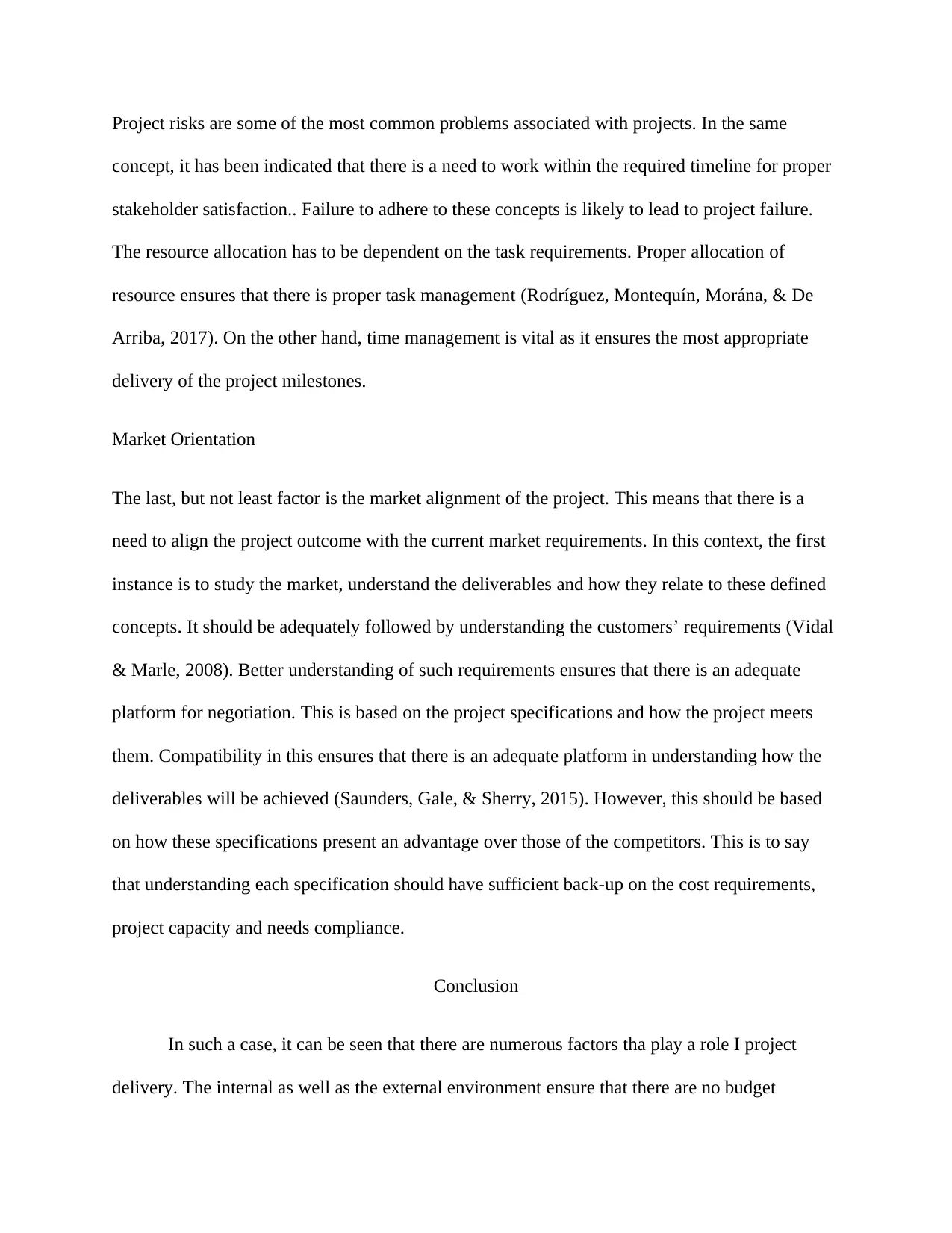
Project risks are some of the most common problems associated with projects. In the same
concept, it has been indicated that there is a need to work within the required timeline for proper
stakeholder satisfaction.. Failure to adhere to these concepts is likely to lead to project failure.
The resource allocation has to be dependent on the task requirements. Proper allocation of
resource ensures that there is proper task management (Rodríguez, Montequín, Morána, & De
Arriba, 2017). On the other hand, time management is vital as it ensures the most appropriate
delivery of the project milestones.
Market Orientation
The last, but not least factor is the market alignment of the project. This means that there is a
need to align the project outcome with the current market requirements. In this context, the first
instance is to study the market, understand the deliverables and how they relate to these defined
concepts. It should be adequately followed by understanding the customers’ requirements (Vidal
& Marle, 2008). Better understanding of such requirements ensures that there is an adequate
platform for negotiation. This is based on the project specifications and how the project meets
them. Compatibility in this ensures that there is an adequate platform in understanding how the
deliverables will be achieved (Saunders, Gale, & Sherry, 2015). However, this should be based
on how these specifications present an advantage over those of the competitors. This is to say
that understanding each specification should have sufficient back-up on the cost requirements,
project capacity and needs compliance.
Conclusion
In such a case, it can be seen that there are numerous factors tha play a role I project
delivery. The internal as well as the external environment ensure that there are no budget
concept, it has been indicated that there is a need to work within the required timeline for proper
stakeholder satisfaction.. Failure to adhere to these concepts is likely to lead to project failure.
The resource allocation has to be dependent on the task requirements. Proper allocation of
resource ensures that there is proper task management (Rodríguez, Montequín, Morána, & De
Arriba, 2017). On the other hand, time management is vital as it ensures the most appropriate
delivery of the project milestones.
Market Orientation
The last, but not least factor is the market alignment of the project. This means that there is a
need to align the project outcome with the current market requirements. In this context, the first
instance is to study the market, understand the deliverables and how they relate to these defined
concepts. It should be adequately followed by understanding the customers’ requirements (Vidal
& Marle, 2008). Better understanding of such requirements ensures that there is an adequate
platform for negotiation. This is based on the project specifications and how the project meets
them. Compatibility in this ensures that there is an adequate platform in understanding how the
deliverables will be achieved (Saunders, Gale, & Sherry, 2015). However, this should be based
on how these specifications present an advantage over those of the competitors. This is to say
that understanding each specification should have sufficient back-up on the cost requirements,
project capacity and needs compliance.
Conclusion
In such a case, it can be seen that there are numerous factors tha play a role I project
delivery. The internal as well as the external environment ensure that there are no budget

overruns, scope creep, and lack of objectivity on project delivery. The vision of the project
manager, market orientation, time and resource management, among other components,
determine the progress of a project. In that sense, it is vital for the project manager to establish a
proper project management methodology and framework.
References
manager, market orientation, time and resource management, among other components,
determine the progress of a project. In that sense, it is vital for the project manager to establish a
proper project management methodology and framework.
References
⊘ This is a preview!⊘
Do you want full access?
Subscribe today to unlock all pages.

Trusted by 1+ million students worldwide
1 out of 16
Related Documents
Your All-in-One AI-Powered Toolkit for Academic Success.
+13062052269
info@desklib.com
Available 24*7 on WhatsApp / Email
![[object Object]](/_next/static/media/star-bottom.7253800d.svg)
Unlock your academic potential
Copyright © 2020–2025 A2Z Services. All Rights Reserved. Developed and managed by ZUCOL.





